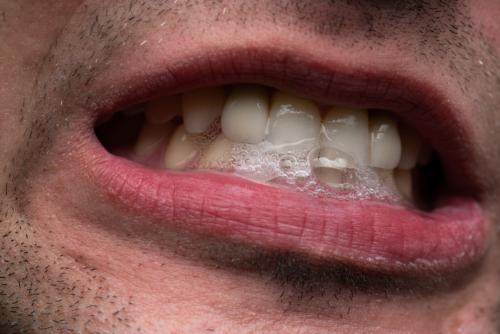Advantages and disadvantages of dental veneers

A) Direct Facing TechniqueThe direct faceting technique involves the following steps: - Choose the color on a tooth adjoined to the pre-moistened tooth, on which the composite will be applied directly on the unspoiled enamel surface in the daylight. Use the color key of the kit. Choosing the color is done by the doctor, along with the patient. - Wash the tooth in question, dry, then isolate to avoid saliva contamination. - Enamel is demineralized, using a demineralizing gel for 15 seconds. - Wash the surface with the water for 15 seconds.
- Fully dry, then apply a layer of light-curing adhesive. - It is photopolymerized for 20 seconds. - Switch to composite material, layer coat. The composite layers should not exceed 2 mm in thickness and be photopolymerized after each layer. Finally, modeling the facet according to the patient's age is done.
Finishing is done with enamelled finishing cutters, then with abrasive strips, polishes and polishes. B) Indirect faceting techniqueIt is an alternative that involves a model made after a pre-made fingerprint with a silicone with a quick socket that the doctor shapes the face of the photopolymerizable composite and then applies it in the same sitting on the tooth. The facet can also be made in the lab by the dental technician on a work pattern after a fingerprint, and then sent for cementing in the cabinet. The laminated ceramic facets are thin sheets of ceramic material applied to the vestibular surface of a tooth prepared for this purpose. They are more resistant to color and wear than composite materials, the aesthetic effect being much better.
Porcelain also has the advantage of not retaining the dental plaque, but porcelain veneers require the removal of a larger amount of enamel. Ceramic facades are indicated in almost all situations where composite resin faces. For example, in children who have dental fractures without dentin interest or teeth that are no longer vital, but are intensely colored. They are also useful in any situation that involves significant loss of enamel, dental malformations or. Patients experiencing color changes in teeth that can not be removed by whitening methods can benefit from a beautiful look with the help of ceramic facets.
It is also the case of those who feel uncomfortable due to or other changes in the shape and volume of the teeth. The advantages of ceramic facets have aesthetically optimal coloring and have a high erosion resistance. Color is stable over time, unlike that of composite facets. Postoperative functional complications are limited. Once attached to the tooth, the facet becomes very resistant to traction and flexion.
The technique of making laminated ceramic facets This type of facets is made only by the indirect method, the doctor taking a silicone impression of the pre-prepared tooth, then pouring a pattern that the dental technician will mold the facet that will then be cemented by the doctor in . The doctor should find out the causes of dental lesions and, if they are caused by eating, it should be changed. Paraffints (vicious habits) that lead to teeth abrasion should be determined and must decide if contraction is contraindicated. Tooth preparation is done in order to obtain sufficient space for porcelain, without overextension or excessive bumping of the restoration. It must be kept in mind to preserve as much as possible enamel.
The preparation of the teeth for the facet is made according to the purpose of the facet and the clinical situation. A facet made to mask a simple dyspromia (color changes) requires simple, basic preparation. If malpractices (mild dental positions) are to be corrected, the preparation will be done appropriately. The porcelain face is made in the laboratory and then sent to the dental office. The doctor will clean the dental surface that will receive the face with a rubber cup and fine ponce stone powder.
The ceramic facet will be thoroughly cleaned and then wetted to increase its transparency and the face will be tested on the dampened tooth and beforehand. If the shape and color are good, the face can be attached to the tooth. Modern dental materials allow optimal dental faces to look and resist. Ask your dentist if your teeth are changed in a negative way. In many situations of this kind, it is sufficient for a simple faceting with composite resins or ceramic materials to rebuild your smile.
Source : sfatulmedicului.ro
Views : 3234
Popular Article
- (photo) Nude becomes art.
Posted: 2018-03-17, 9815 views.
- The harmful effects of air conditioning on the skin
Posted: 2017-06-08, 8529 views.
- 3 causes of dyed hair discoloration
Posted: 2017-06-15, 8409 views.
- Why early puberty occurs in girls: symptoms, favors, diagnosis and treatment
Posted: 2017-10-24, 8253 views.
- Good or bad skin treatments in the hot season
Posted: 2017-06-07, 7983 views.
Recommendations
- (photo) Nude becomes art.
Posted: 2018-03-17, 9815 views.
- The harmful effects of air conditioning on the skin
Posted: 2017-06-08, 8529 views.
- 3 causes of dyed hair discoloration
Posted: 2017-06-15, 8409 views.
- Good or bad skin treatments in the hot season
Posted: 2017-06-07, 7983 views.
- Risks of practicing sports on hot days
Posted: 2017-06-12, 7559 views.
 4 effective ingredients in the fight against acne.
4 effective ingredients in the fight against acne. How to get rid of hiccups fast
How to get rid of hiccups fast The wheat bran diet: the secret of lost pounds as if by magic
The wheat bran diet: the secret of lost pounds as if by magic The recipe that will sweeten your soul this weekend!
The recipe that will sweeten your soul this weekend!  Is it dangerous or not to refreeze meat after thawing it?
Is it dangerous or not to refreeze meat after thawing it?  The unusual sign of diabetes indicated by saliva.
The unusual sign of diabetes indicated by saliva. What to drink to boost your immune system.
What to drink to boost your immune system. 10 foods that help you never age.
10 foods that help you never age. What actually happens in your body if you drink a cup of coffee for breakfast
What actually happens in your body if you drink a cup of coffee for breakfast 5 surprising benefits of chia seeds
5 surprising benefits of chia seeds